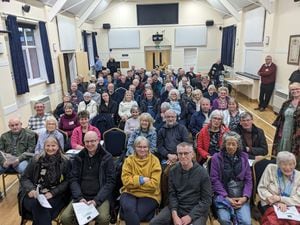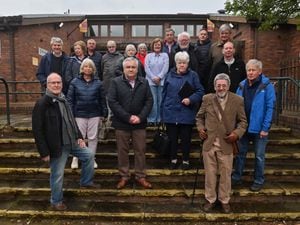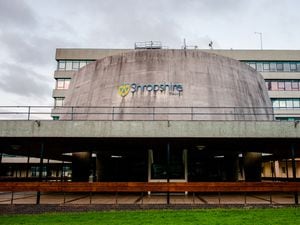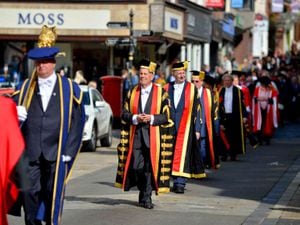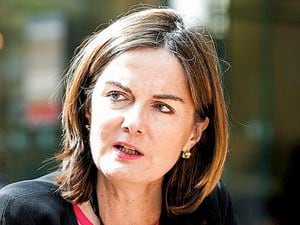Question Time: The grand inquisitors from Day to Dimbleby as Fiona Bruce takes up the baton
As Fiona Bruce takes over Question Time, here’s how her predecessors fared.
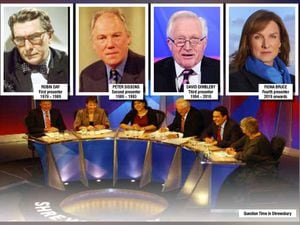
When Fiona Bruce takes the chair for the first time on Question Time tonight, she will be in no doubt about the shoes she is stepping into.
In its 40-year history, Question Time has had just three main presenters, with two of them earning a place as true legends of broadcasting history.
And the third? Well, let’s just say he struggled to to live up to his illustrious predecessor.
Question Time made its screen debut on September 25, 1979, as a television version of the popular radio programme Any Questions. It was only intended to run for a short while, but under the chairmanship of ‘The Grand Inquisitor’ Robin Day, it proved to be surprisingly popular.
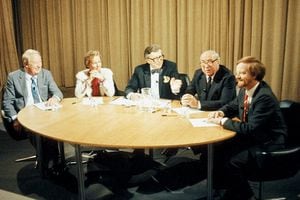
Day, a one-time Liberal candidate for Hereford, was central to the show’s popularity. His distinctive bow tie and thick-rimmed spectacles made him one of the most instantly recognisable political commentators of his time. His acerbic wit and combative style showed that politics could be entertaining.
The first show began in a chaotic fashion, with the first questioner – a Miss Charlton – unaware of which of her many questions had been selected. After a lot of fumbling and mumbling, Day took control by asking the question himself.
There was just one serving MP on the panel – deputy Labour leader Michael Foot, who maintained his reputation for sartorial elegance by appearing in a brown V-neck sweater. The Tories were represented by the colourful ex-MP Teddy Taylor, who had just lost his Glasgow seat, and he was joined around the table by novelist Edna O’Brien and the Catholic Archbishop of Liverpool Derek Worlock.
Watch highlights of the first 25 years:
Day’s quick-witted one-liners helped make Question Time such entertaining viewing. When a member of the audience preceded a question with the caveat: “I’m not a great lover of Mrs Thatcher,” he swiftly interrupted: “I’m very glad to hear it, sir.”
When a bored-looking historian Sir Alan ‘A J P’ Taylor answered every question with a monosyllabic ‘yes’ or ‘no’, Day warned him: “If you don’t answer the questions properly, you won’t get your fee.”
While Day will always be synonymous with the programme, he actually only occupied the hot seat for its first 10 years. In 1989 he was replaced by Peter Sissons, who quickly discovered that following a giant of broadcasting was no easy feat.
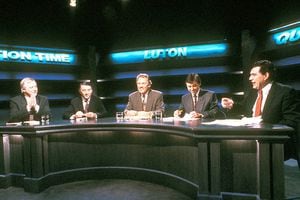
To be fair to Sissons, his time coincided with a general greying of the political scene, when the larger-than-life figures of the 70s and 80s were being replaced by the blander, more moderate faces who would dominate the 90s. Margaret Thatcher made way for John Major, the animated Neil Kinnock was replaced by the more sober John Smith. At least by this time the forgettable SDP/Liberal Democrat leader Bob Maclennan had made way for Paddy Ashdown.
While Sissons was certainly an accomplished and respected newscaster, he lacked the warmth and wit which made Day’s time in the big chair such a compelling spectacle. While Question Time continued to attract political big-hitters and strong audiences, his time at the helm was very much in the vein of George Lazenby’s stint as James Bond. A solid performer, but one who always lived in the shadow of his predecessor.
One great successes of Sissons’ time as host, though, was the decision to start moving the show around the country. For its first 10 years, the show was filmed at London’s Greenwood Theatre, but under Sissons’ tenure it was hosted at a variety of different locations. His time at the helm also marked the introduction of the curious Q-shaped table. Sissons stepped down in 1993, and enjoyed a distinguished career as one of the BBC’s main news presenters until 2009.

For Sissons’ successor, the BBC took no chances, and set heavyweights Jeremy Paxman and David Dimbleby head-to-head in dummy shows. It was a clash of the two contrasting styles – Dimbleby was the avuncular pillar of the establishment, the son of BBC stalwart Richard Dimbleby, while Paxman was the new kid on the block, the thrusting young Newsnight presenter who made his name by mercilessly grilling politicians.
In the end, the BBC went for Dimbleby’s gentler style. It was reported that while Paxman was good at handling the panellists, Dimbleby had the better connection with the audience. He later said he would have been prepared to ‘do cartwheels on the lawn’ it if was what it took to land the job.
The Dimbleby years saw the return of much of the light-hearted banter seen during the Robin Day era.
Memorable moments included Dimbleby ordering an unruly member of the audience to leave for repeatedly heckling the panel. The man sheepishly walked out of the studio like a recalcitrant schoolboy. When Dimbleby mispronounced the late Robin Cook’s name as Robin Cock, the Labour MP responded, “Yes, David Bumblebee”.
Once, Dimbleby attempted to tease Tory MP Jacob Rees-Mogg about his privileged background by asking him if his ideas were shaped “on the playing fields of Eton”.
“Yes,” Rees-Mogg drawled, pausing dramatically for effect. “I was at school with your son.”
Fiona Bruce has beaten off formidable competition to land one of the most prestigious roles in broadcasting. Time will tell whether she will join Robin Day or David Dimbleby in the pantheon of the show’s history, or whether she will become another footnote like Peter Sissons. But millions will tune in to find out.

